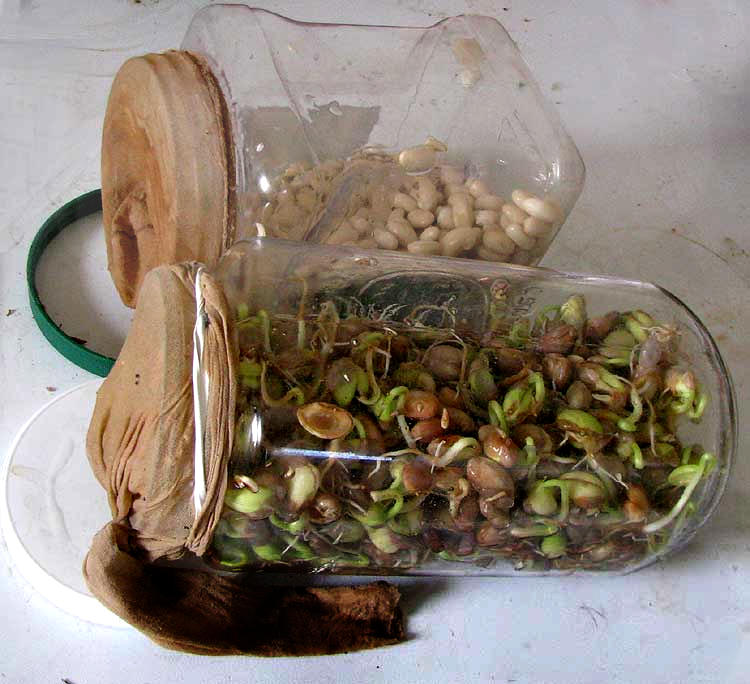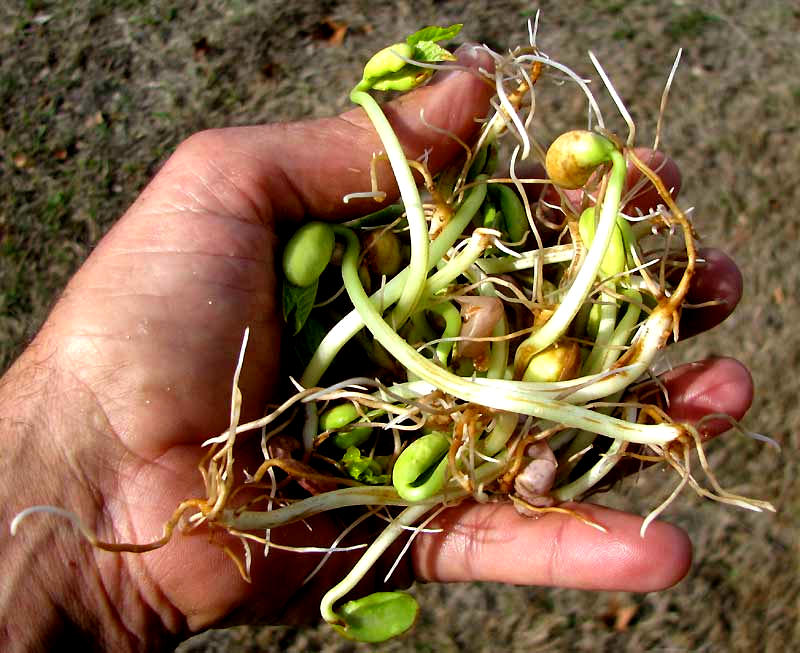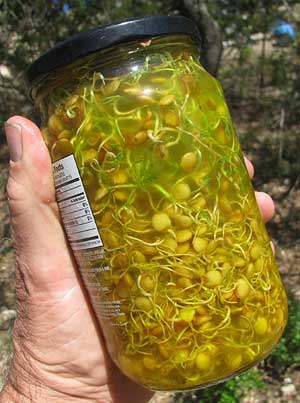Excerpts from Jim Conrad's
Naturalist Newsletter

from the February 3, 2013 Newsletter issued from the valley of the Dry Frio River in northern Uvalde County, southwestern Texas, on the southern border of the Edwards Plateau; elevation ~1750m (~5750 ft); N29.62°, W99.86°; USA
SPROUTING LARGE BEANS
Whenever my life is settled enough to have access to large jars, clean water and beans, an important part of my diet consists of bean sprouts that I sprout myself. I find the tastiest of sprouts to be those of radish, alfalfa and mung bean, but here I don't have those beans, so I sprout what I can find. Lately that's meant pinto and white Great Northern beans, the latter being very similar to Navy, or Boston, beans, and all available on the shelves of the local supermarket.
One of my most popular web pages is the one describing how to sprout alfalfa beans at https://www.backyardnature.net/simple/alf-spr.htm.
2): Sprouts of larger beans may contain enough compounds to upset some people's stomachs. Sensitivity to these compounds varies tremendously from person to person. Break down compounds in large sprouts by heating them -- stir fry them, include them in simmering soup, bake them in cornbread, etc. And eat large sprouts in moderation. Sprouts of small beans also contain these compounds, but in such small amounts that the problem is negligible. If you develop flatulence and/or diarrhea, lay off the bean sprouts.
Sprouting larger beans follows the same procedure. At the top of this page you can see two jars of sprouts I'm growing this week -- pinto beans up front and Great Northern in the back.
Those are patches of a lady's stockings covering the mouths. Here's how I sprout them:
I pour beans about an inch deep into a jar, run it half full of water and let them soak overnight. Next morning I pour off all the water, secure a stocking patch over the mouth, and turn the jar on its side. Two or three times a day I pour water into the jars, swirl it gently, then pour it out. This keeps fungus and bacteria from building up. By the second day little white roots begin arising from the beans, then day after day the sprouts grow, the rate of growth depending on the temperature. The pinto beans up front in the above picture are maybe four days old. They're turning green because enough sunlight bounces around the kitchen for photosynthesis-enabling chlorophyll to be activated, which is good because that enhances the beans' nutritional value.
In fact, I read that when beans sprout, their stored complex compounds, which are fairly indigestible, break down into simple compounds that enhance the beans' nutritional content by up to 1200%. And the organic compounds produced by sprouted beans are readily assimilated by the body. You can see a handful of sprouted pinto beans just the way I like them below:

One way I prepare large bean sprouts is to mix a handful into my cornbread batter, and make a kind of thin-bodied, hard-crusted bean cornbread that bakes quickly in a skillet over a fire.
Another approach is to sauté big bean sprouts. They quickly soften and lose their bitterness, and in fact don't have much taste at all. I like to sauté equal amounts of large bean sprouts and shredded cabbage, the end result tasting mildly of sauerkraut. I spritz bowls of this with a sauce made of ¼ vegetable oil, ¾ vinegar poured into a small jar filled with minced fresh onion and garlic with a bit of salt, and boy that's good with hot slabs of cornbread.
I don't notice a gas problem when I eat a lot of these sprouts, so maybe it's true what I read about the sprouting process reducing the beans' oligosaccharide content, which causes the gas problem. Oligosaccharides are a type of carbohydrate that enzymes and bacteria in the stomach can't digest, so it lasts until special bacteria in the large intestine decompose it, forming carbon dioxide, the gas, and water. It's funny that some people worry about eating foods with oligosaccharides because they think it's bad for them, while others make a special effort to eat them, saying that in the intestines oligosaccharides feed "good bacteria," which displace "bad bacteria."
Really you don't know who to believe in these matters and that's why I just eat lots of bean sprouts because I like them, my body seems to react favorably to them, and they taste so good with hot cornbread. Below you can see one of my recent slabs of bean-sprout-filled cornbread moments before I slapped a big handful of fresh cilantro and spinach leaves onto them and doused the herbage with my special onion and garlic sauce:

from the February 17, 2013 Newsletter issued from the valley of the Dry Frio River in northern Uvalde County, southwestern Texas, on the southern border of the Edwards Plateau, USA
FINE-TUNING SPROUTING LARGE BEANS
Now have more results to report.
I've tried Pinto, Great Northern and Black-eyed Beans. Pinto gave the best results, Black-eyed the worst, and Great Northern was so-so, but really not so hot. The latter two bean types are more prone to fungal and bacterial contamination, the beans becoming mushy and stinky.
However, I've also tried lentils, and these I find to sprout nearly as easily and contamination free as alfalfa seeds. Below you can see some sprouted lentils ready to be sandwiched between slabs of hot cornbread or spread as garnish atop a soup:

Raw, sprouted lentils are described by a nutritional data website as "... very low in Saturated Fat, Cholesterol and Sodium. It is also a good source of Thiamin, Iron, Phosphorus and Copper, and a very good source of Vitamin C, Folate and Manganese." It says that one cup of sprouted lentils provides 19% of the folate, 14% of the iron and 21% of the Vitamin C required of a 2000 calorie diet.
By the way, the website providing this information is very good and easy to use. It's at https://nutritiondata.self.com/.
from the April 27, 2014 Newsletter issued from the valley of the Dry Frio River in northern Uvalde County, southwestern Texas, on the southern border of the Edwards Plateau; elevation ~1750m (~5750 ft); N29.62°, W99.86°; USA
A GOOD USE FOR OLD PICKLE JUICE
 Like many people who buy jars of pickles at the grocery, my neighbor Phred feels bad about throwing away the juice once the pickles are gone. The juice, after all, contains lots of good vinegar and such noble condiments as garlic, cloves, tumeric, mustard seeds, and more. Phred gives me his pickle juice, which I spritz onto this and that for flavor, or maybe add a bit of oil to it and marinate sliced garlic from the garden in it for a really garlicky dressing. And lately I've been trying something else:
Like many people who buy jars of pickles at the grocery, my neighbor Phred feels bad about throwing away the juice once the pickles are gone. The juice, after all, contains lots of good vinegar and such noble condiments as garlic, cloves, tumeric, mustard seeds, and more. Phred gives me his pickle juice, which I spritz onto this and that for flavor, or maybe add a bit of oil to it and marinate sliced garlic from the garden in it for a really garlicky dressing. And lately I've been trying something else:
I keep three or four jars of various kinds of sprouting beans going all the time, at different stages of sprouting, so that I never run out. Sometimes I end up with more sprouts than I can eat, so I stuff the surplus into one of Phred's jars of pickle juice, sweet pickle juice being preferred. The sprouts marinate and the longer they soak the better they taste in a sandwich, added to an omelet, or just eaten from the jar. Here you can see a jar of lentil sprouts marinating in sweet pickle juice.
One problem with this technique is that the sprouts taste so good you might want to too much, resulting in flatulence and/or diarrhea. If you feel your stomach growling a few hours after eat raw beansprouts, stop eating them awhile, and when you return to them, don't eat so many.